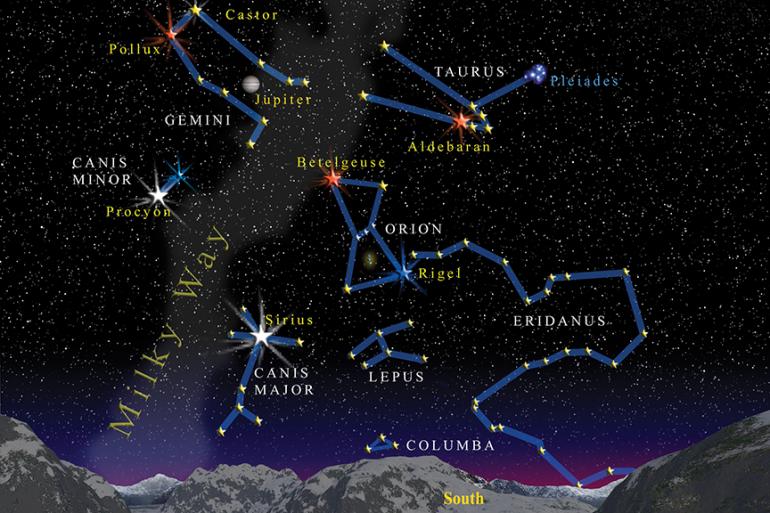The Hare Up There
If provisions ran short on the journey west and a feller had to live off the land, chances are a jackrabbit or two eventually ended up in his pot. Widespread and fecund, they were plentiful and not bad eating; it shouldn’t be surprising that a representative of this ubiquitous family ended up in the sky.
Nor should it be surprising that Lepus the hare ended up in proximity to the premier hunter of the constellated sky: none other than Orion. And Orion is the much easier find, so start with him.
Going out in the chill middle evening on clear winter nights, you can hardly miss him: a prominent rectangle of bright stars high up in the south framing his burly form, and a line of three bright stars bisecting it at an angle to form his shining belt. Once you’ve found Orion, look directly below him to find the celestial bunny. Lepus consists of much fainter stars (in keeping with his wisely unobtrusive nature), but two rather distinctive curved lines of three stars each, one below the other, outline his body.
There seems no definitive myth about Lepus, but it’s been said he was placed in the sky to give something for Orion and his two dogs, Canis Major and Minor (just to the left of Orion) to hunt, and they’re all within striking distance. There is, however, an ancient cautionary tale about unintended consequences that prominently features the rabbit. It seems that a fellow imported a pregnant hare to the isle of Leros; people began to raise them and before they knew it, they were up to their eyeballs in bunnies. Locusts had nothing on these voracious reproducers, and they soon brought the island to the brink of starvation. An extraordinary effort was needed to drive them off the island, and one was placed in the sky as a moral.
It was a moral unheeded in more modern times; just substitute Australia for Leros and you have a 19th century repeat of the story, with imported rabbits running amok and remaining a serious pest problem Down Under to this day.
A more fanciful story has Lepus transformed from bird to bunny by Ostara, the goddess of spring. She allowed the hare to run as fast as it could formerly fly, and to lay eggs once a year in a nod to its former life. Hence Ostara, from whose name Easter was derived, can be held responsible for the famous Bunny who delivers all those decorated eggs for Easter morning.
If Orion and his dogs tire of hunting the rabbit, they can look a little farther afield for more game. For directly below Lepus lurks a faint triangle of stars forming Columba the dove, observable if your southern horizon is low enough and the sky is dark. Columba is a more modern-day constellation, added not in antiquity but by Plancius in 1592 to fill a hole. As such, it represented the dove Noah sent scouting for dry land after the Great Flood.
But Columba also works well as the dove Jason sent flying through the Symplegades, the “Clashing Rocks” in the passage between the Aegean and Black Seas, in one of the great voyaging tales of Greek mythology. The rocks tended to grind together at the most inappropriate times, which made it a bit problematic for Jason to steer his ship Argo between them. So the mariner sent the dove through first to see if the bird could make it. Columba lost only a few tail feathers, and the following Argo lost only a little stern and made it through.
Birds and bunnies… perhaps not the heroic quests we normally associate with the Great Hunter of the sky, but they’re filling if a feller’s feeling a bit peckish. And while they require a bit of hunting to find in the sky, it seems entirely in keeping with their elusive behaviors on earth. If you’re up to the challenge, have a go at finding Lepus and Columba, all part of the grand tableau wheeling above the snowy fields of winter on those dark, cold nights.
Jim Manning is currently executive director of the Astronomical Society of the Pacific in San Francisco, but lived outside Bozeman for many years and visits regularly.












